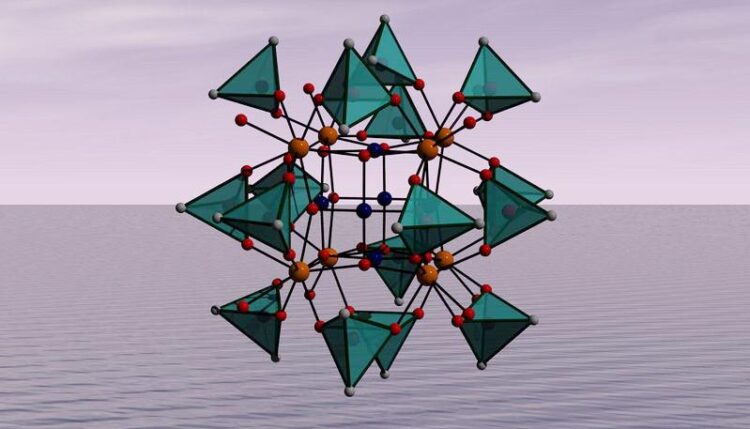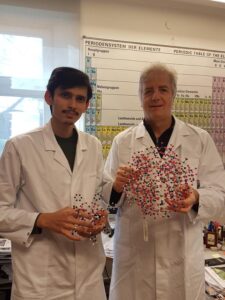Chemists at Jacobs University Discover New Class of Compounds

Structural representation of the novel cationic palladium-oxo cluster.
Credit: Jacobs University
Scientists at Jacobs University Bremen led by Ulrich Kortz, Professor of Chemistry, have achieved a breakthrough in the field of precious metal-oxo chemistry. For the first time, researchers have synthesized cationic, meaning positively charged, metal-oxo clusters based on palladium. They report on the synthesis and properties of these compounds in the renowned journal Angewandte Chemie, which classifies the article as a Hot Paper and thus as a particularly important contribution. The research project involved the working groups of four professors at Jacobs University.

Credit: Jacobs University
Kortz is a pioneer in the research area of anionic metal-oxo clusters, a class of compounds also known as polyoxometalates (POMs). His research group discovered the subclass of polyoxopalladates (POPs) in 2008 and has continuously developed it further ever since. A large number of these structurally and functionally interesting compounds have since been published by his research group. These compounds are primarily anionic, meaning that they are negatively charged. Saurav Bhattacharya, an experienced researcher of Professor Kortz’s work group, developed a series of neutral POP species for the first time in 2020, which was a breakthrough in itself at the time. Now, continued efforts by him have led to the discovery of two cationic palladium-oxo clusters (POCs).
“This is a highlight in our research. By incorporating the rare earth elements cerium or thorium next to palladium, we were able to prepare the first cationic POCs. This now allows us to study their interactions with different anionic species, and takes us into completely new research areas,” said Kortz. The new materials have a number of potentially interesting properties. For example, biomedical studies can be conducted where supramolecular host-guest chemistry plays an important role. The goal, for example, is to transport medically active substances into the body in a targeted manner. Possible applications could also be in the field of carbon dioxide reduction and industrial catalysis.
With respect to their molecular structure, the cationic palladium-oxo clusters are built like a Matryoshka doll. The core consists of a 6-palladium(II)-oxo unit surrounded by eight cerium(IV) or thorium(IV) ions. This assembly is further capped by 16 dimethylarsinate groups and eight water molecules, resulting in the formula [Pd6O12M8{(CH3)2AsO2}16(H2O)8]4+ (M = Ce, Th).
For the investigation of some properties of the new class of compounds, Ulrich Kortz also called on the expertise of other scientists at Jacobs University. The working groups of chemists Professor Werner Nau and Professor Nikolai Kuhnert as well as physicist Professor Veit Wagner were involved in the studies. “One of the strengths of Jacobs University is the mutual interest of colleagues in close, transdisciplinary and collegial collaborations,” said Kortz. “Our labs are spatially close to each other, and we know and complement each other well.” Also involved was chemist Professor Pawel Kulesza from the University of Warsaw, Poland.
About Jacobs University Bremen:
Studying in an international community. Obtaining a qualification to work on responsible tasks in a digitized and globalized society. Learning, researching and teaching across academic disciplines and countries. Strengthening people and markets with innovative solutions and advanced training programs. This is what Jacobs University Bremen stands for. Established as a private, English-medium campus university in Germany in 2001, it is continuously achieving top results in national and international university rankings. Its more than 1,600 students come from more than 110 countries with around 80% having relocated to Germany for their studies. Jacobs University’s research projects are funded by the German Research Foundation or the EU Research and Innovation program as well as by globally leading companies.
For more information: www.jacobs-university.de
Wissenschaftliche Ansprechpartner:
Ulrich Kortz
Professor of Chemistry
eMail: u.kortz@jacobs-university.de
Tel.: +49 421 200-3235
Originalpublikation:
Discrete, Cationic Palladium(II)-Oxo Clusters via f-Metal Ion Incorporation and their Macrocyclic Host- Interactions with Sulfonatocalixarenes
https://doi.org/10.1002/anie.202203114
Media Contact
All latest news from the category: Life Sciences and Chemistry
Articles and reports from the Life Sciences and chemistry area deal with applied and basic research into modern biology, chemistry and human medicine.
Valuable information can be found on a range of life sciences fields including bacteriology, biochemistry, bionics, bioinformatics, biophysics, biotechnology, genetics, geobotany, human biology, marine biology, microbiology, molecular biology, cellular biology, zoology, bioinorganic chemistry, microchemistry and environmental chemistry.
Newest articles

Innovative 3D printed scaffolds offer new hope for bone healing
Researchers at the Institute for Bioengineering of Catalonia have developed novel 3D printed PLA-CaP scaffolds that promote blood vessel formation, ensuring better healing and regeneration of bone tissue. Bone is…

The surprising role of gut infection in Alzheimer’s disease
ASU- and Banner Alzheimer’s Institute-led study implicates link between a common virus and the disease, which travels from the gut to the brain and may be a target for antiviral…

Molecular gardening: New enzymes discovered for protein modification pruning
How deubiquitinases USP53 and USP54 cleave long polyubiquitin chains and how the former is linked to liver disease in children. Deubiquitinases (DUBs) are enzymes used by cells to trim protein…



